Hassan wakes me up at 7, so I am packed and on the road at 8 am already. That allows me to see the sun waking up over Azaghar n’Irs and getting slowly into the turns of the canyons, the women walking on their way to the fields, while some road workers are already on the job.
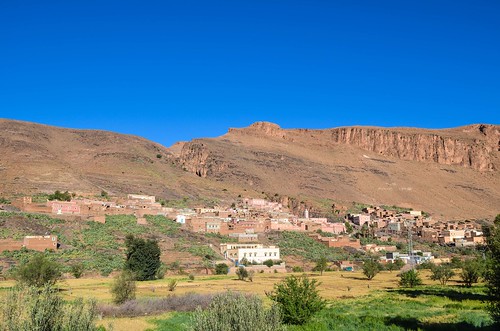
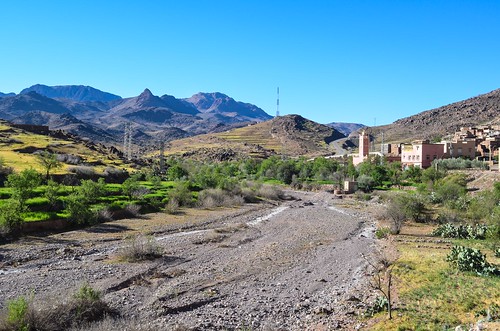
I reach Ouzoune at 9:30 just when the first shop of the market opens for breakfast, and I did 20 km already. I also meet girls surprisingly talkative on the road. They wanted sweets, money, why not my camera, or a wedding, with photos on their cellphones of them well dressed with loose hair and sunglasses as supporting documents.
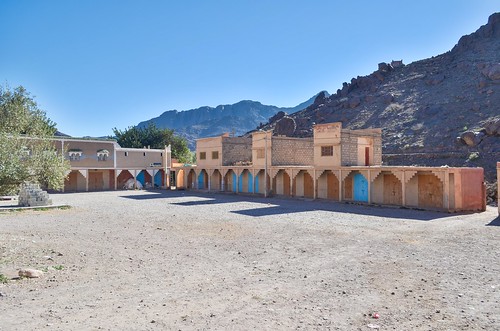
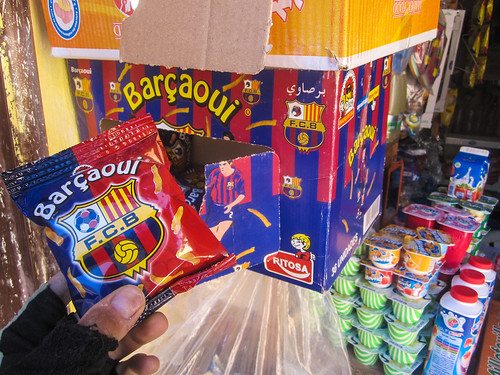
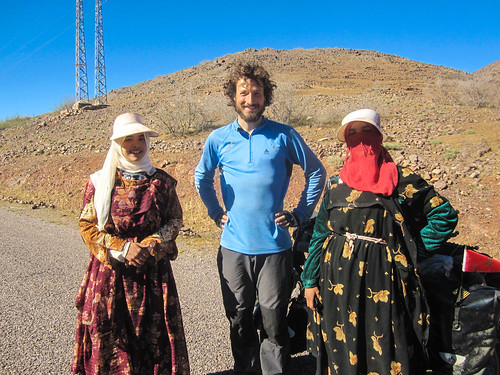
From Ouzoune to Igherm, that’s a tough uphill stretch, but to be enjoyed as perhaps the last one of Africa. The sun is hot and my pace slow.

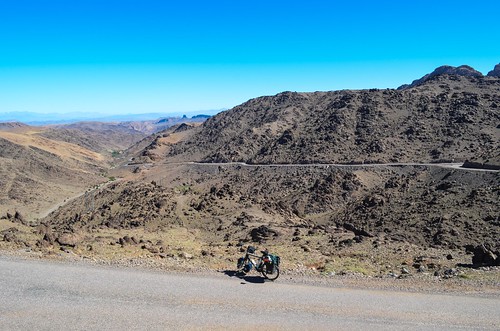
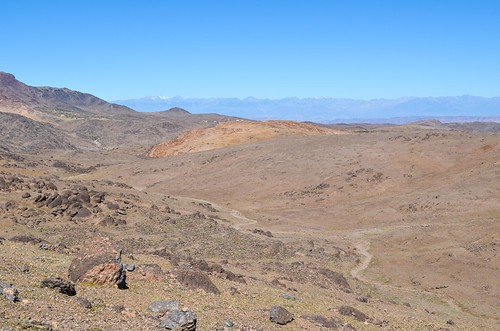
After the climbing, there are still 20 km not entirely flat to reach Igherm.
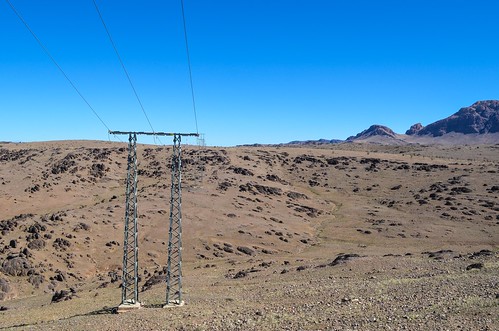

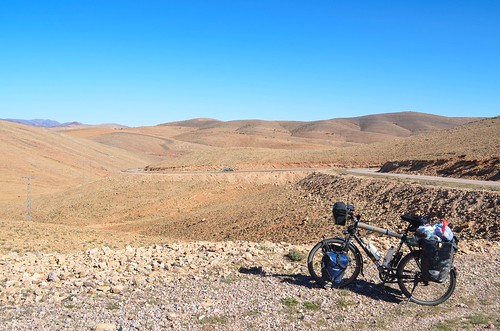
Once in Igherm, I reward myself with 2 meals of goat intestines for a change of tagines and am ready to enjoy what people describe as “just downhill until Tafraoute”. Tafraoute is 85 km away so I doubt I will have it downhill all the way, but at least easy. This is not the case at all, the road is never flat. Always up or down between 1700 and 1900 meters high. The good point is that it’s warm and very scenic. Sometimes I am crossing an infinity of yellow hills. Sometimes a village behind a turn and green fields. Sometimes blossoming almond trees. Most of the time though, I see only stones.
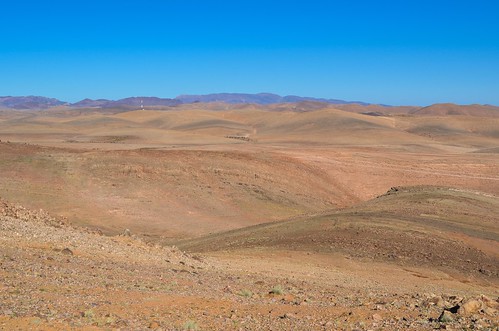

During the last hour, under the warm colors of the sun setting, I see only 2 motorbikes and almost no one by the road. It feels like riding after the end of the world, going up hills, and down, and up again, but still as many of them coming to me. It’s been now more than 10 hours that I am on the saddle and my legs turn mechanically, my back is sweating in the ascents, and drying in the (always too short) descents.
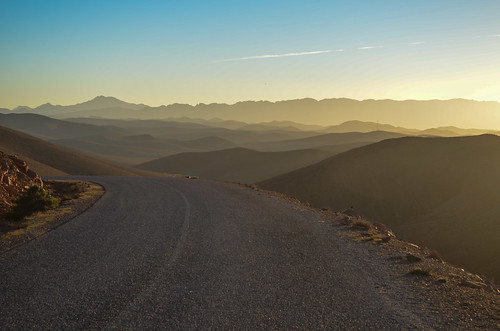
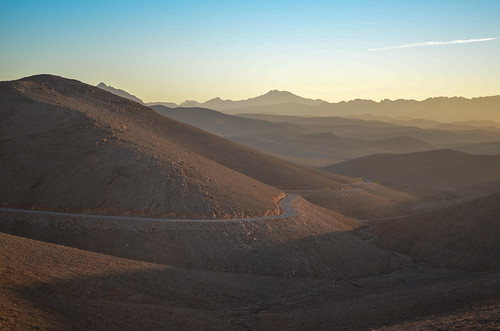

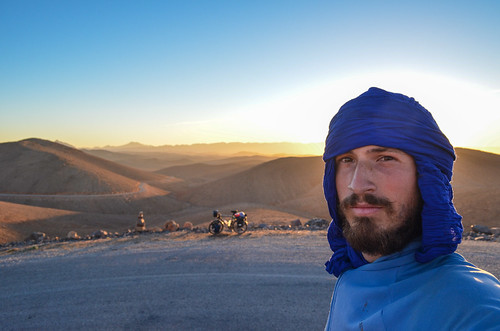
At the critical sunset time, a few kilometers before the village of Tiguemine, I take a small piste until the land is flat enough and the stones small enough to camp on it. There is nothing better than stones here to sleep on, but I find a spot almost cleared of them behind a tree. The almond trees are often planted along dry stream beds, I don’t know when they receive water, but it seems to work somehow.
Even though I carefully chose my campspot, hidden from the piste that is away from the road, I managed to meet 2 young people walking there. Morocco is a country that looks very empty in so many places but has always a random walker/herdsman/woman picking things on the top of a hill.
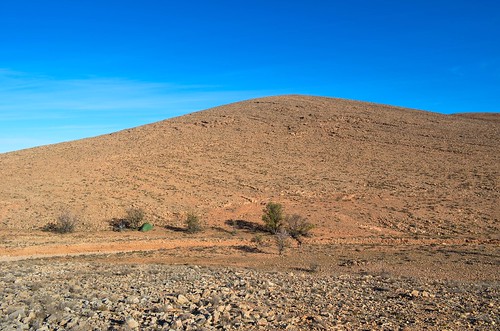
Just as I was falling asleep, I hear something roaming around my tent. First surprised as there “should” be nothing, second scared as this something is big enough to make big stones move, then very intrigued by the “sssshhhhhwwwwpp sssshhhhhwwwwpp” sounds it makes, I get out of the tent to see. As there’s a colony of big ants under the next tree, I am expecting to see a big anteater, the animal that eats ants with its tongue. Even though I doubt it can exist in this part of the world, I cannot imagine anything else. Despite the full moon brightness, I see nothing moving, throw a couple of stones in the direction of the sounds and go back to sleep.
I am much less afraid of the dogs here than in Spain where they were aggressive and for sure dangerous. Here they seem coward. They are often treated by the locals with stones and run away.
The treatment of trash is also as simple as the treatment for dogs: put your trash into a plastic bag, make a knot, and throw it as far from you as possible. Behind a wall or across the road.
I put my cheche from the morning as the sun is already strong. Besides saving on sun cream, it is really useful for keeping the humidity around my lips. On the first day of strong sun in the Ziz gorge, I had cracked lips that took 5 days to heal with chub stick. Since I put the cheche on them, they have been fine.
The first village I cross is just behind the hill, it is called Tiguemine / Tighermine. It’s home to 5 small kids, future bandits of the road, that stop even the camper vans to ask for anything. They ask me for cigarettes. The local old men sitting around throw stones at them, just like for dogs, to keep them away from me while I am getting a few items at the shop.

My midday objective is the town of Tafraoute, recommended by many. The road is still going up and down around 1700 m high, but as going uphill must be taking 5 to 10 times more time than going downhill, I feel mostly like being climbing.
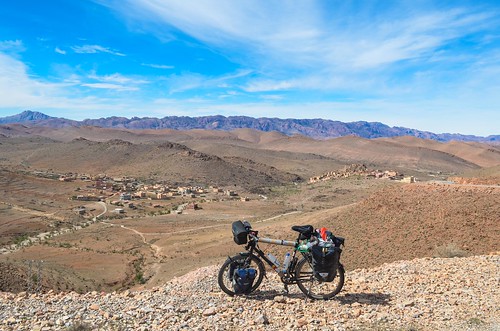
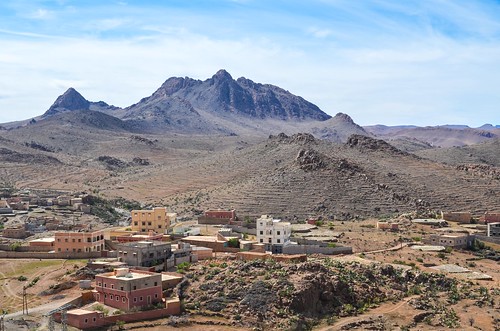
I see on a milestone “Tafraoute 18 km”, which is a big disappointment as my calculations were letting me thing I am less than 10 km from it. I’m sure of my calculations and of what I saw on the previous milestones, but anytime the road meets another one, there seems to be a reshuffling of the milestones kilometers.
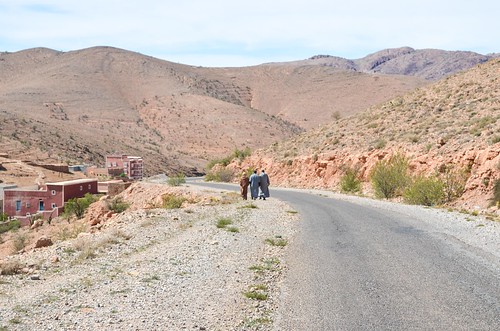
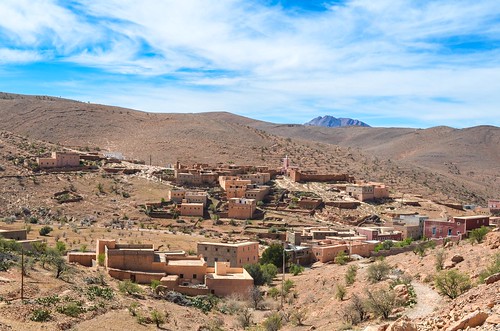
The good point is that those last 18 km are made of a great descent is a fantastic landscape. The yellow stones and hills are less yellow, they are sharper, and many trees bring more contrast into it. I finally make it to Tafraoute, sit with a tagine for 2 and can finally eat a lot.
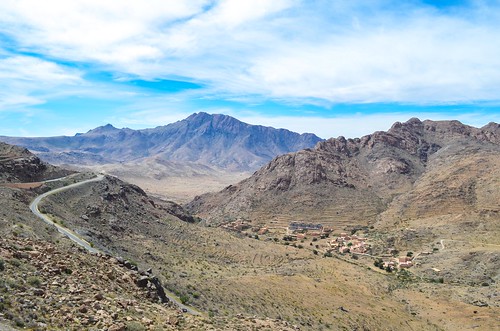
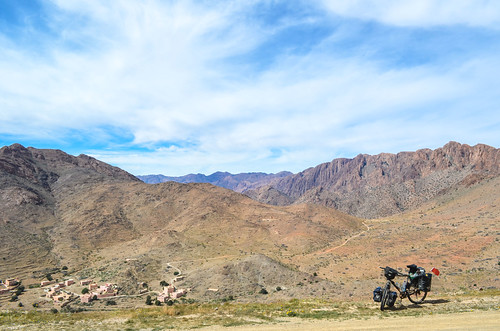

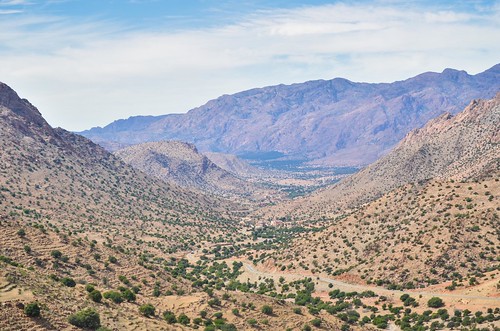
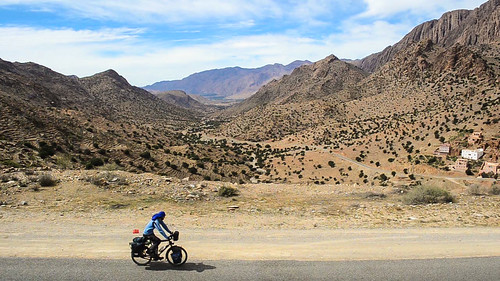
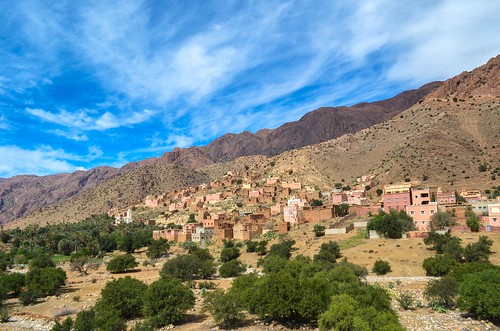
What I see while eating is the most shocking happening of the recent days, more than small kids stopping cars on the road to beg for adult things. The town is filled with old White men and women in shorts. And in Morocco (for what I’ve seen excluding Rabat and Casa), there is just no one wearing shorts. Even among the kids, I have seen no one without the legs covered until the ankle. And suddenly, half of the people walking on the main street have legs, arms and shoulders uncovered (and often more red than white). I am not even sure if I have seen locals in tee-shirt, I think everyone cover their arms too. With what one sees now, it’s very close to deduce that Europeans wear only short pants. Tafraoute has many campgrounds, all so filled with camper vans they look like factories. Many of the camper vans also pull a second small car, a buggy or a motorbike behind. I had heard Agadir, not far from here, was a colony of retired Europeans, and seeing it already in Tafraoute, I am glad I am not going to Agadir.

Instead, I will be going to Tiznit and further on to the coast to Sidi Ifni, already more than 100 km south of Agadir. I have hard time getting back on the bike, as a tagine for 2, despite looking small, combined with two breads, really fills up a single stomach.


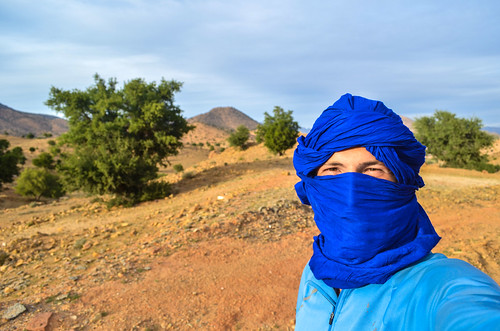
The sky is cloudy and the ground windy, it looks like it will rain. I am hailed by Hassan in a turn of a pass. By lack of jobs in biology, he is the night guard of a camp for road workers and invites me to camp with him. Even though I don’t like to stop in the middle of the ascent of a pass, it is already 6 pm and it will save me the task of looking for a good campspot later, so I pitch my tent behind a container. We eat together in his tent before I crash. I know now why so many of the place names here begin with “ta”: Taroudant, Tazenakht, Tafraoute, Taliouine, Tazazert, Tahala … It is the mark of the female in Tamazight, and the place names are all female. It works also for Tangier, Tétouan, Tarfaya, etc.
I have to wake up at 6:30 because the workers arrive at 7 am. That makes a hard wake-up in the darkness but also an easy day with plenty of time to reach Tiznit 80 km away. We make a plan to meet again with Hassan in Tighmi, halfway to Tiznit, as Wednesday is the souk day.
The weather is still deteriorating and I even receive droplets of water. I hope it will get clearer by the coast. There is a long 15 km descent to Tighmi, similar to the 15 km descent I did yesterday to reach Tafraoute. This one is much less scenic, entirely due to the thick fog that makes the road dangerous.

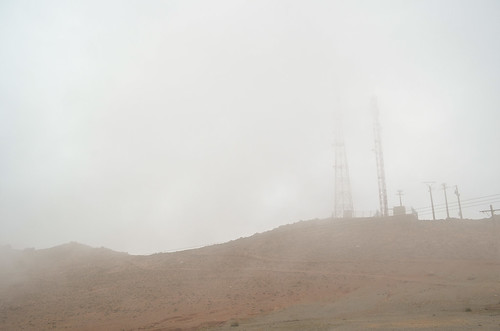
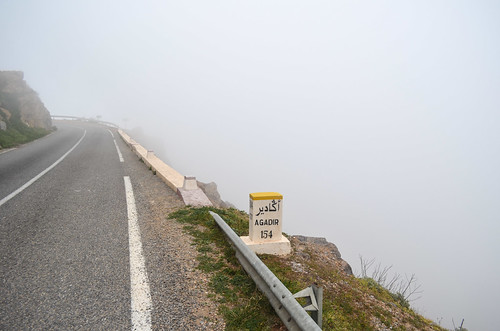
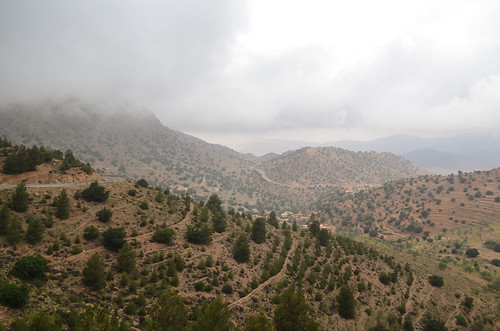
I am now under 500 meters high, which didn’t happen since … Fès, one month ago! At the exception of the sand dunes in Merzouga, around 800 m high, I have almost always been above 1000 m since I left Fès for Ifrane in the Middle Atlas. So this descent feels like a landing back on the ground, the land of the flat roads. It feels instantly much warmer.
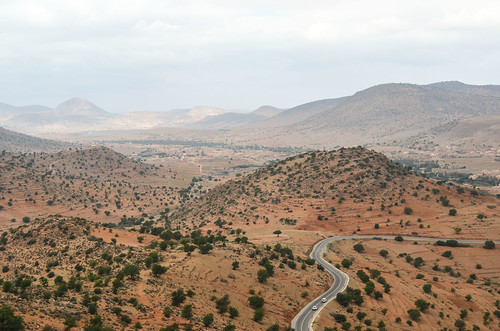
The small town of Tighmi is bustling on this day, everyone coming to buy and sell, or maybe coming to see friends coming to buy and sell. We have a quick lunch with Hassan and I continue for the second half, 40 km of rather flat road until Tiznit.
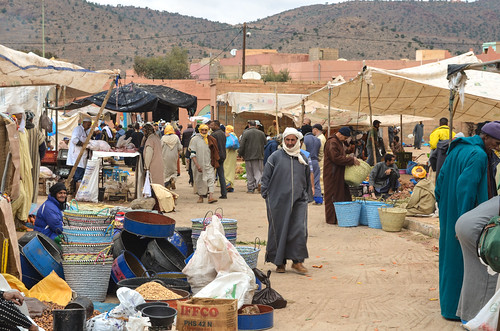
These last 40 km are boring and much longer than I thought, as the wind is against me, limiting me to ridiculous speeds. If this is a foretaste of what awaits me for 1500 km in the Sahara, it is not motivating at all.
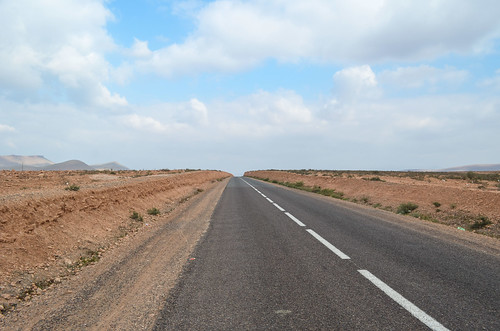
After greeting every single milestone on the road from KM 20 down to KM 1, I reach finally Tiznit, a rather big city, with many foreigners on bicycles between the medina and their camper van in the campground. I struggle to find the cheap hotels in the medina, all at the same location, next to the 50 shops of babouches. For 40 dh I have not even a collective shower but I am looking forward to the end of the day tomorrow, in Sidi Ifni by the coast, and take a couple of days of rest there.
I check on the internet the weather forecast for the next days by the coast and in the Sahara: no rain, and the wind is always from the north! I know a 10-day forecast of the wind is hardly reliable, but it makes me confident for the next step.

My legs are really tired and I need those rest days, and I’ve decided to leave the bustling and noisy Tiznit to rest by the coast in Sidi Ifni, a former Spanish enclave, now a surfing spot. That makes 75 more kilometers to go.
I have a headwind when leaving Tiznit towards the west and am eager to know if, according to the Google wind forecast, the wind will suddenly change direction to push me from the north as I’ll be riding the coast southbound.

That’s a sunny easy day on a high quality newly asphalted road, the only non-flat being a small hill from 200 to 400 m that separates Tiznit from Mirleft on the coast. It feels more humid and I feel more relaxed from knowing the mountains are behind me. I will probably feel bored without them, if half of my vision field is taken by a boring water surface (and even more in the Sahara if the other half of my vision field is taken by stones and sand). But for now, I’m excited to ride by the coast, which didn’t happen since the very beginning of my Moroccan leg around Tétouan.
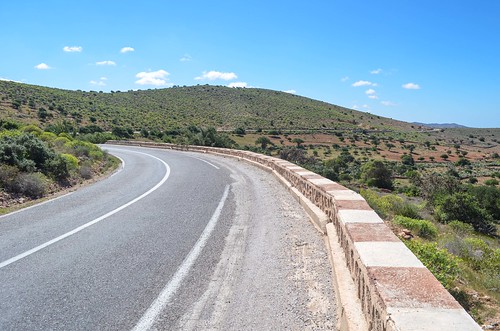
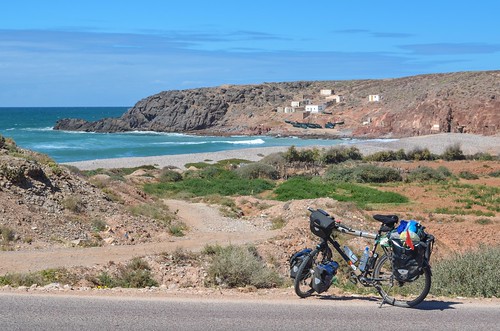
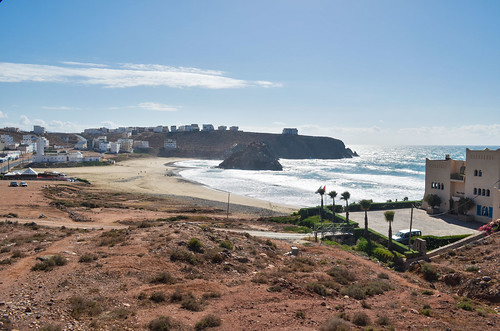
The wind surprisingly follows the forecast and is now pushing me. That’s a pleasure to just think that the daily headwinds fought for a week to come back from the Atlas until the coast are over.

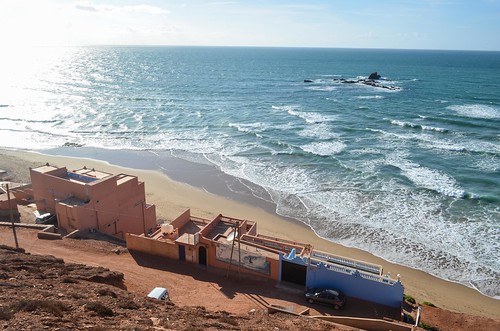
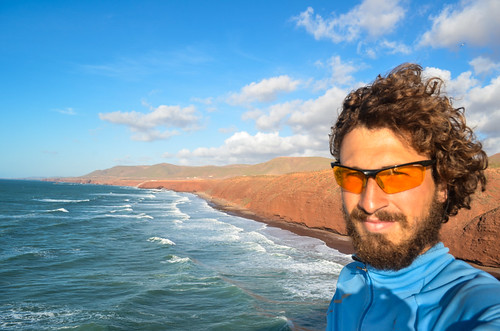
Sidi Ifni’s entrance starts with a 2 x 2 lanes newly paved street. The town is right by the beach, I see 2 surfers going back to their hotels, many foreigners and many camper vans, but not too many. The “cool” hotel of the town, Suerte Loca, is full and doesn’t takes bicycles in, so I start my tour of all the hotels of Sidi Ifni. Many are as cheap as 35 dh (3 €) for the night, but without any facilities more than a bed. I need to rest correctly and want an attached bathroom that delivers hot water at anytime (add 20 dh for each of the 3 aforementioned criteria. Once the bargain made with a good hotel by the beach, a priceless warm shower in a room with a view on the beach and the sound of the waves, I can go out in town with a special mission: eat fat stuff that will keep me “energetic” for the Sahara crossing. The desert starts at Guelmin, which is just 60 km away. We have dinner with the German couple who overtook me by car no less than 4 times since Igherm (300 km ago). Avocado juice, caramel cake, fries and fishes, olives, salads and fruits, everything edible ends up in my belly.

Sidi Ifni, with an architecture consequence of the Spanish control until 1969, and an airstrip right in the middle of the town, is a very relaxed and nice place. Sadly, my Mauritanian visa, received with wrong dates, is valid since yesterday already. I have now 30 days to exit that country while I am still 1500 km before the entrance border. Having to upload pictures and update my blog, to perform a full maintenance of my bike and washing clothes, that’s a stressful relaxation time I have here.
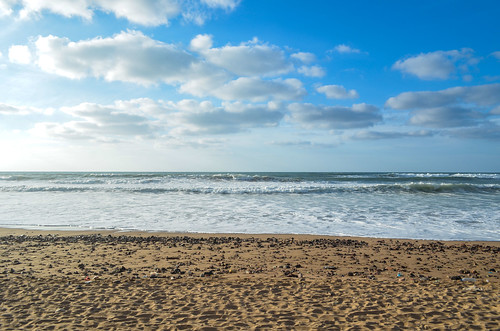
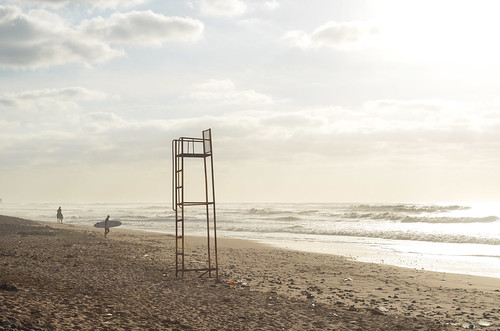
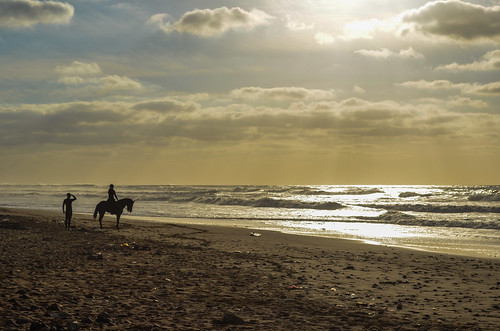
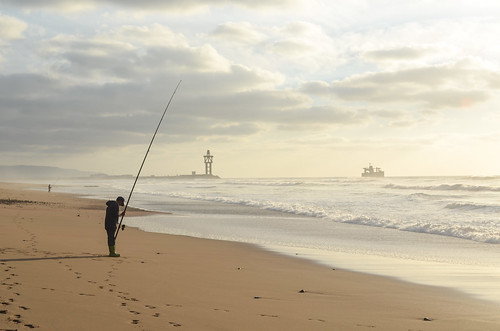
In a supermarket for retired Europeans, I find the Chips Ahoy cookies! That is almost a miracle. Sadly, the cheese didn’t follow:
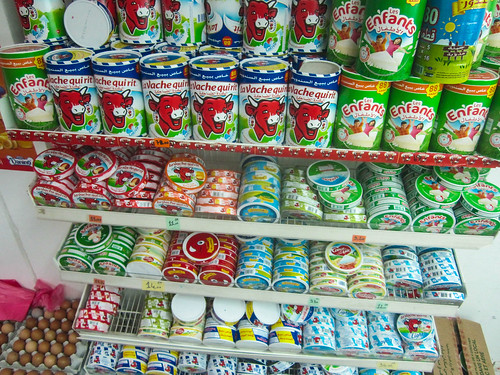
Because the next roads will be empty and soon part of Western Sahara, I can conclude on my cycling experience in Morocco: surprisingly wonderful. I had started with a negative bias and it is true that the Rif, as well as unbearable touristy spots like Marrakech, are not welcoming and there is more struggling than enjoyment. However, the stunning and varied landscapes (mountains, snow, plateau, desert, dunes, oasis, rivers, canyons, valleys, forests) and the people of the countryside always nice made it a very rewarding trip for 2 months and 2300 km.
From now on, the long desert stretch of the Sahara is awaiting me. The wind forecast is now negative but I am looking forward to the challenge.







Inspiring; you did an excellent job while traveling.
Really nice pictures. You are a true adventurer.
Good luck where ever you are now.
hello,
pour la météo tu connais le site
https://www.accuweather.com
prévisions jusqu’à 25 jours et heure par heure, vent ….très complet
Oui je regarde ca pour chercher des bonnes nouvelles … mais les previsions du vent a long terme, j’y crois pas trop